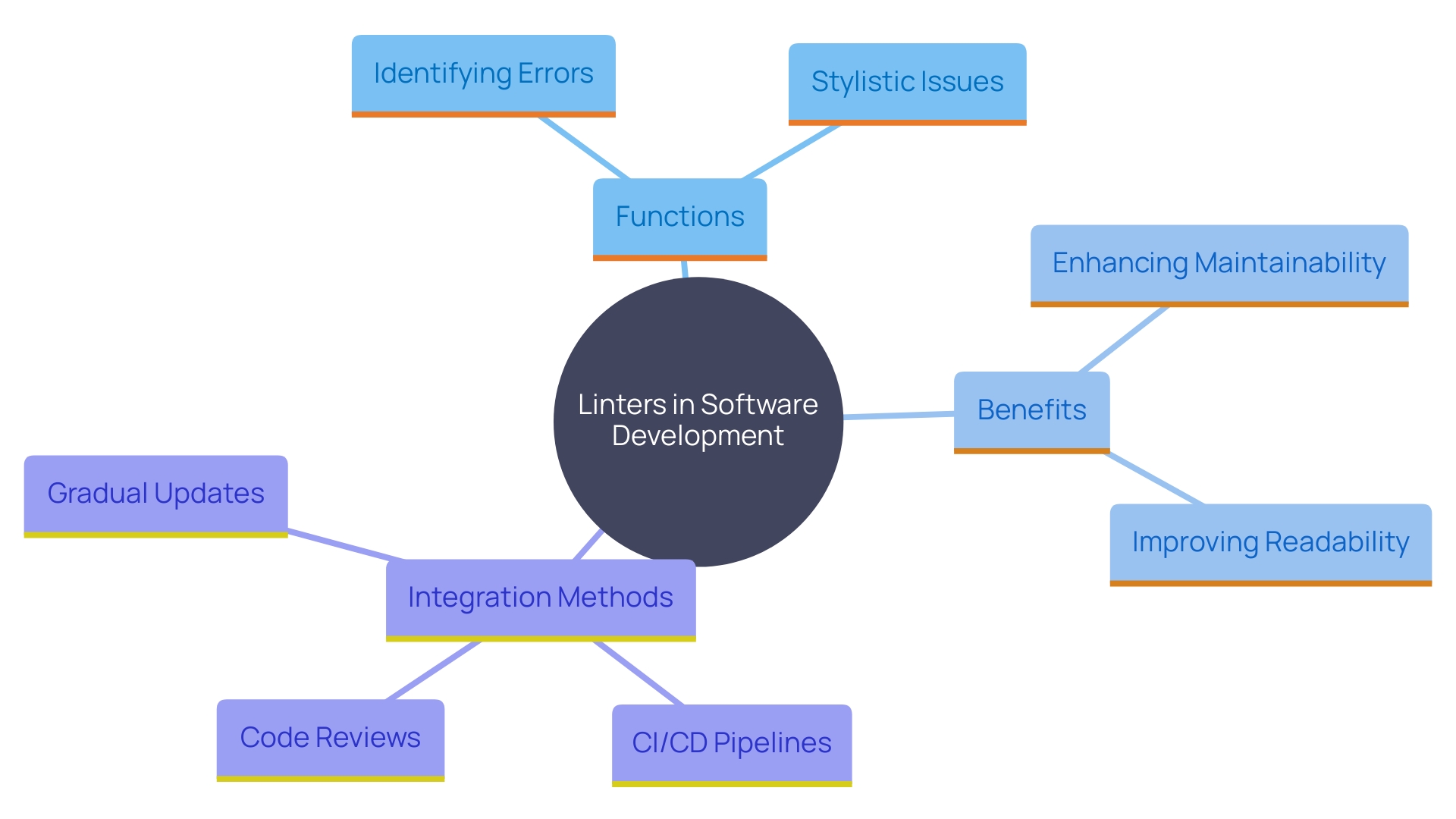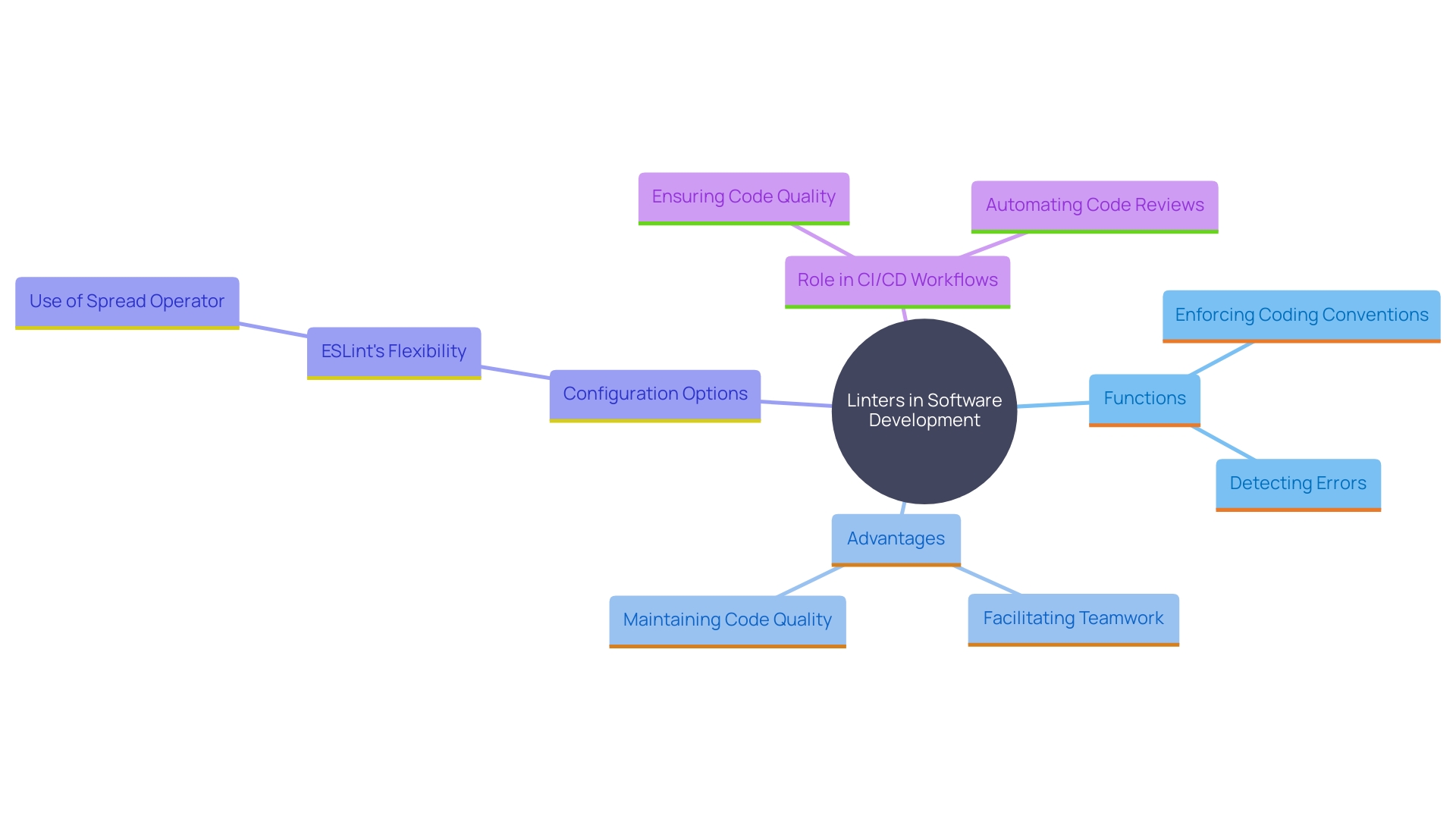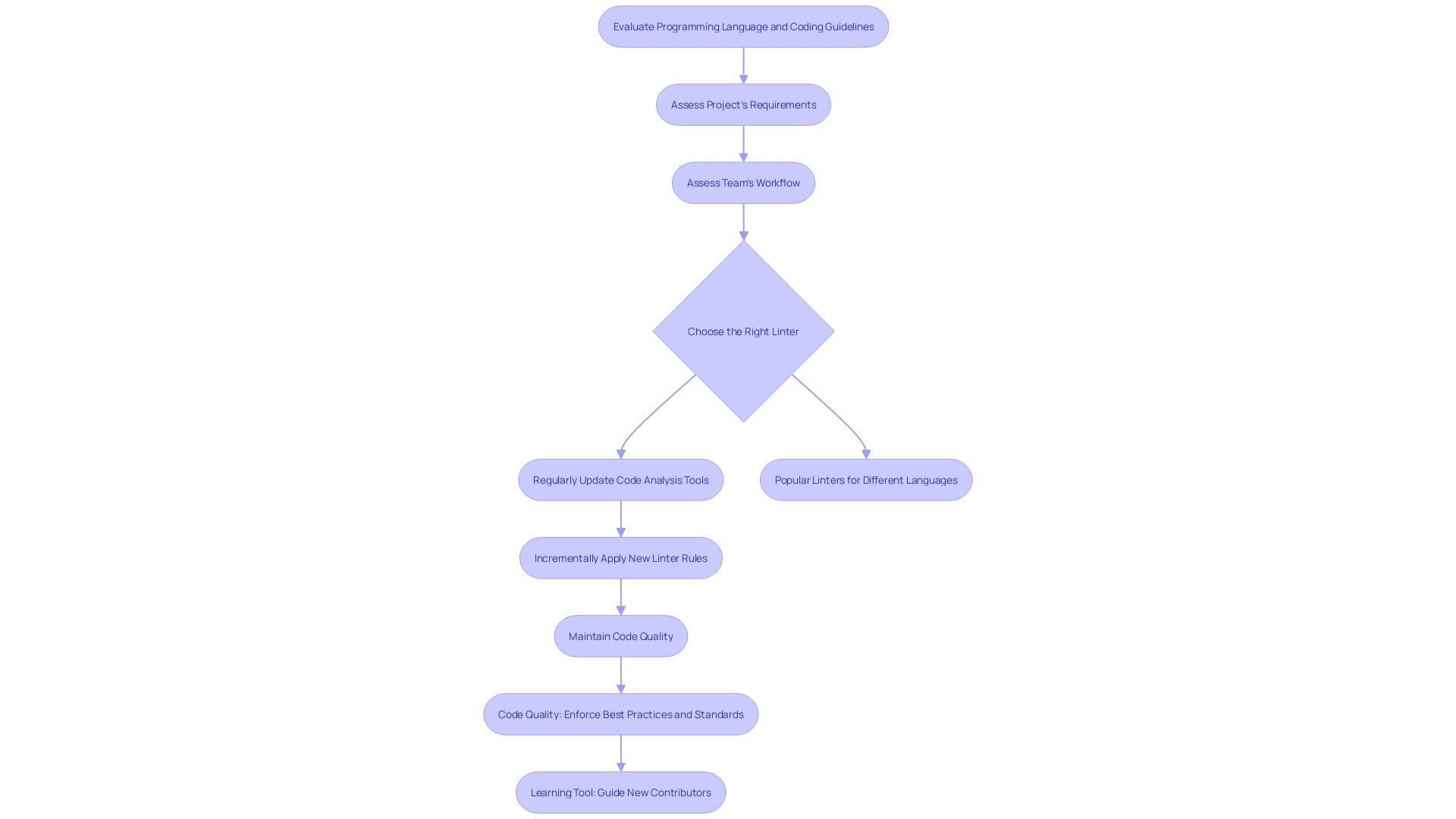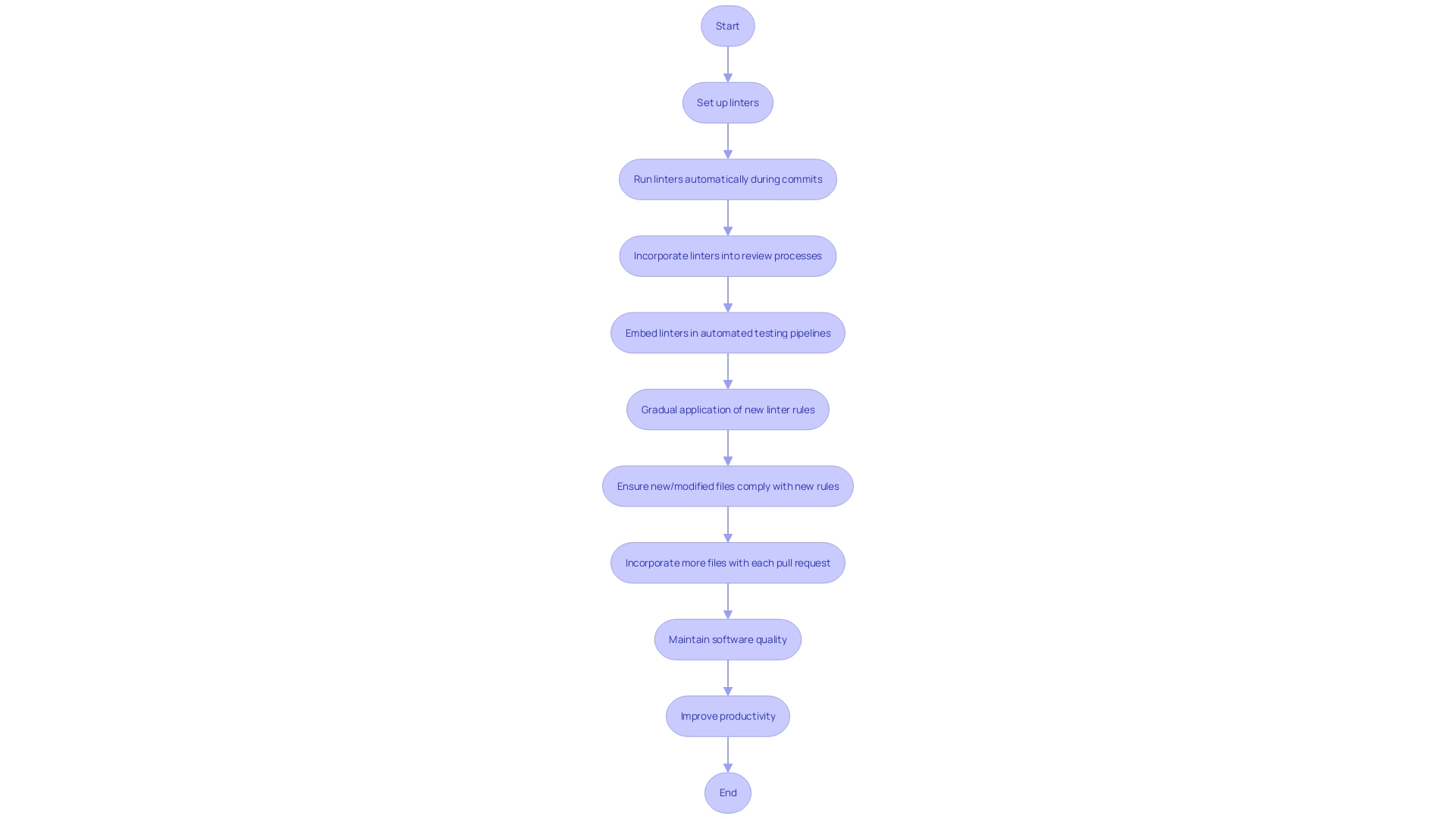Introduction
In the fast-paced world of software development, maintaining high code quality is paramount. Linters, as static code analysis tools, play a crucial role in this process by identifying potential errors and stylistic issues before code execution. By integrating linters into development workflows, such as CI/CD pipelines, developers can ensure that their code adheres to established standards, thereby enhancing maintainability and readability.
This article delves into the history of linters, their various types, and the substantial benefits they offer in improving code quality and collaboration among team members. Additionally, it explores practical applications of linters in programming and provides guidance on choosing the right linter for specific projects. Through seamless integration into development workflows, linters not only streamline processes but also significantly boost overall productivity and efficiency.
What is a Linter?
A linter is a static analysis tool that examines your program to identify potential errors and stylistic issues before execution. By offering critiques on aspects ranging from syntax mistakes to logical discrepancies, these tools guarantee that programs conform to set guidelines. Incorporating tools for analysis into your development process, such as through CI/CD pipelines, not only enhances software standards but also unifies best practices across teams. These tools capture unused variables and overcomplicated expressions, enhancing maintainability and readability of the program. Despite their limitations in providing a holistic system view, static analysis tools offer rapid, low-overhead feedback, making them essential for maintaining high software quality.

History of Linters
The concept of linting has its origins in a Unix utility called 'lint', developed in the late 1970s. It was originally intended to examine C language source material and identify frequent errors like type mismatches and syntax issues. Over time, code quality tools have evolved to support a wide range of programming languages, including JavaScript, CSS, HTML, and Markdown. These tools have become integral to modern software development, helping developers detect bugs, potential security vulnerabilities, and maintain code quality.
Today, these tools provide various configurations and rules, making it possible to tailor their functionality to specific project needs. Developers can install code quality tools directly into their editors, such as VS Code, and share configuration files across teams to maintain consistent coding standards. This flexibility guarantees that tools are not solely focused on imposing coding styles but also on maintaining the accuracy and dependability of programming.
Furthermore, tools are now equipped with features such as 'ignore' files and special comments to disable rules for certain lines or sections of programming. This adaptability is crucial for maintaining code hygiene and readability, especially in large projects. As code analyzers and their guidelines continue to evolve, staying updated with new configurations and best practices becomes essential for leveraging the latest features and development approaches.
Despite their significance, these materials are sometimes disregarded in favor of other development tasks. Nevertheless, incorporating and consistently refreshing tools for analysis can greatly improve the standard of programming and diminish the chances of facing major problems later in the development phase.
Benefits of Using Linters
Linters provide substantial benefits, such as better quality of programming, increased readability, and less time spent on debugging. By examining scripts for mistakes and promoting optimal methods, tools guarantee uniformity across projects, enabling smooth cooperation among team members. For instance, Meta Llama has been especially successful in directing developers toward improved simplification and maintainability through detailed feedback. 'Furthermore, contemporary code analyzers such as ESLint enable gradual adoption of new regulations, ensuring that only new or altered files must comply with revised criteria, thereby streamlining the task of preserving code quality over time.'. This gradual approach has been instrumental in making future changes easier to implement. By catching errors early in the development process, linters streamline workflows and significantly boost overall productivity. The consistent application of coding standards also leads to better performance and structure, aligning with industry standards and ultimately enhancing the scalability and maintainability of the codebase.
Types of Linters
Linters are essential instruments in the programming realm, designed to assist developers in maintaining clean and consistent programming practices. They can be categorized into several types based on their functionality and the languages they support. Common types include syntax checkers, style checkers, and security linters. Each type concentrates on various elements of software quality, enabling developers to select the most appropriate tools for their particular requirements.
Syntax checkers ensure that programs adhere to the proper syntax rules of a programming language, catching simple errors like missing semicolons or unmatched brackets. Style checkers, conversely, enforce programming conventions and stylistic guidelines, assisting teams in preserving a consistent style. Security analyzers are specialized tools that identify potential security weaknesses within the programming, such as common injection flaws or insecure configurations.
Setting up and adjusting these tools can initially appear as a single task, but keeping them current is essential for preserving high programming standards. Contemporary tools, such as ESLint, provide versatile configuration choices and can adjust to changing coding standards. In addition, tools such as Lefthook can streamline the oversight of these analyzers by incorporating them into workflows, guaranteeing that only new or altered files are examined during review processes. This gradual implementation approach helps teams adopt new linter rules without overwhelming developers or disrupting ongoing projects.
By utilizing these various kinds of code analyzers and maintaining their settings current, developers can greatly enhance the overall standard, security, and uniformity of their codebases.
Applications of Linters in Programming
Linters are crucial instruments in contemporary software creation, guaranteeing that programming follows designated excellence criteria from the initial writing phase through ongoing integration. Their primary function is to enforce coding conventions and detect errors, ranging from simple syntax issues to complex logic flaws. By incorporating style checkers into development environments and CI/CD workflows, teams can uphold uniform programming quality, even in rapid collaborative contexts.
A significant advantage of utilizing code analysis tools is their ability to facilitate teamwork by enforcing uniform coding standards. As each developer brings a unique programming style, tools assist in harmonizing these differences, reducing conflicts and improving readability. This is particularly crucial in collective projects where consistent code quality is paramount.
Moreover, these tools can be configured to apply changes gradually. Instead of overhauling an entire project to comply with new rules, code analysers can enforce updates incrementally with each pull request. This approach not only simplifies the process but also reduces the risk of introducing errors during mass updates.
Additionally, modern code analyzers offer extensive configurability. For example, ESLint, a popular JavaScript linter, uses the spread operator for configuration extension, allowing developers to tailor the tool to their specific needs. This flexibility guarantees that code analyzers stay pertinent and efficient, adjusting to new coding norms and practices over time.
By incorporating style checkers into CI/CD workflows, teams can automate programming assessment reviews, ensuring that only submissions meeting the specified standards are deployed. This automation is essential for preserving high standards in dynamic development settings, where manual inspections would be impractical and time-intensive.
In summary, linters are indispensable for maintaining high programming quality and facilitating effective teamwork in software development. Their integration into development environments and CI/CD pipelines ensures consistent, reliable, and maintainable code, ultimately leading to more efficient and successful project outcomes.

Choosing the Right Linter for Your Project
Choosing the right linter requires a thorough evaluation of various factors, including the programming language, specific coding guidelines, and the team's workflow. It's essential to consider the project’s requirements and ensure that the chosen linter aligns with the team's coding standards and practices. Many developers often overlook the necessity of updating code quality tools, mistakenly viewing their configuration as a one-time task. However, code analysis tools evolve along with other libraries, and their rules need regular updates to maintain code quality and relevance.
In older projects, where components are written using outdated approaches and obsolete rules, updating code analysis tools becomes even more critical. Strict release deadlines that prioritize business features over technical upkeep often contribute to project aging. As a result, when urgent updates are required—like migrating to the latest Node.js LTS version or updating essential libraries—developers find themselves scrambling to catch up. This urgency emphasizes the significance of not overlooking code analyzers in the maintenance process.
To effectively implement linter updates, modern code analysis tools provide functionality for extending configurations, making it easier to gradually incorporate new rules. For instance, ESLint uses the spread operator for extending configurations, allowing developers to apply changes incrementally. This approach ensures that new and modified files adhere to updated linter rules without necessitating immediate, comprehensive project-wide edits. By integrating these updates into each pull request, the codebase gradually aligns with the new standards, thereby enhancing maintainability, reliability, and performance efficiency.

Integrating Linters into Your Development Workflow
To fully harness the power of code analysis tools, they must be seamlessly integrated into the development workflow. This can be achieved by setting up tools to run automatically during commits, integrating them into review processes, or embedding them in automated testing pipelines. For example, incorporating linters into your Continuous Integration/Continuous Deployment (CICD) workflow guarantees that builds fail if non-compliant programming is detected, enforcing coding standards across the team. This approach not only encourages a culture of software quality but also enables ongoing enhancement.
By gradually applying new linter rules to new and altered files during review processes, the task of updating linter configurations becomes manageable and less disruptive. Modern tools like ESLint allow for extending configurations using methods like the spread operator, making it easier to adapt to new coding standards without overhauling the entire project at once. This gradual adoption helps maintain high software quality over time, as evidenced by studies showing significant improvements in productivity and software health when linters are properly utilized.
Linters examine your program to identify potential issues, ranging from syntax errors to logic flaws. They direct developers on best practices, such as spacing and usage patterns, standardizing style across the team. This standardization is crucial, as it ensures consistency and reduces the time spent on code reviews, ultimately enhancing overall project efficiency.

Conclusion
In the realm of software development, linters have emerged as vital tools for enhancing code quality and ensuring adherence to best practices. By providing immediate feedback on potential errors and stylistic issues, linters not only improve maintainability and readability but also foster collaboration among team members. Their historical evolution from the original Unix utility to contemporary multi-language support underscores their significance in modern development workflows.
The benefits of integrating linters into the development process are manifold. They streamline workflows by catching errors early, thus reducing debugging time and enhancing overall productivity. Moreover, linters allow for gradual implementation of new rules, making it easier for teams to maintain high coding standards without overwhelming developers.
This flexibility is crucial for adapting to changing project requirements while ensuring consistent code quality.
Choosing the right linter and integrating it effectively into CI/CD pipelines is essential for maximizing its advantages. Regular updates and configuration adjustments can significantly enhance code maintainability and performance. By embedding linters into the development workflow, teams can automate code quality checks, ensuring that only compliant code is deployed.
This not only cultivates a culture of quality but also leads to more efficient and successful project outcomes, ultimately reinforcing the importance of linters in achieving excellence in software development.
Frequently Asked Questions
What is a linter?
A linter is a static analysis tool that reviews your program to identify potential errors and stylistic issues before it runs. It checks for syntax mistakes and logical discrepancies, ensuring that the code adheres to defined guidelines.
How do linters improve software quality?
Linters enhance software quality by offering critiques on various aspects of the code, such as unused variables and overcomplicated expressions. This leads to improved maintainability and readability, as well as a reduction in bugs and security vulnerabilities.
What are the historical origins of linting?
The concept of linting originates from a Unix utility called 'lint', which was developed in the late 1970s for examining C language source code to identify errors like type mismatches and syntax issues.
Which programming languages can linters support?
Linters have evolved to support a wide range of programming languages, including but not limited to JavaScript, CSS, HTML, and Markdown.
How can developers integrate linters into their workflow?
Developers can integrate linters into their development environments and CI/CD pipelines, allowing them to run automatically during commits and code reviews, ensuring that only compliant code is deployed.
What types of linters are available?
Linters can be categorized into several types, including syntax checkers (which check for syntax errors), style checkers (which enforce coding conventions), and security linters (which identify potential security vulnerabilities).
How do linters help with team collaboration?
Linters enforce uniform coding standards across projects, reducing conflicts and improving code readability, which is essential for collaborative work where multiple developers contribute to the same codebase.
Can linters be customized?
Yes, linters can be configured to suit specific project needs. Developers can share configuration files across teams and use features like 'ignore' files to disable certain rules for specific code sections.
Why is it important to keep linters updated?
Keeping linters updated is crucial as they evolve alongside other libraries and coding standards. Regular updates help maintain code quality and relevance, especially in older projects where outdated rules may lead to issues.
What is the benefit of gradually applying new linter rules?
Gradually applying new linter rules allows teams to implement changes incrementally with each pull request, simplifying the process and reducing the risk of introducing errors during comprehensive updates.
What are the advantages of using modern linters like ESLint?
Modern linters like ESLint provide flexible configuration options and allow for gradual adoption of new rules, ensuring only new or modified files comply with updated standards, which streamlines code quality maintenance.
How do linters impact overall productivity?
By catching errors early in the development process and promoting best practices, linters streamline workflows, significantly enhancing overall productivity and ensuring high software quality.




